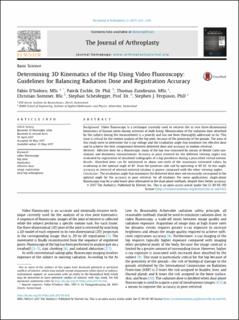Please use this identifier to cite or link to this item:
https://doi.org/10.21256/zhaw-3581Full metadata record
| DC Field | Value | Language |
|---|---|---|
| dc.contributor.author | D'Isidoro, Fabio | - |
| dc.contributor.author | Eschle, Patrik | - |
| dc.contributor.author | Zumbrunn, Thomas | - |
| dc.contributor.author | Sommer, Christian | - |
| dc.contributor.author | Scheidegger, Stephan | - |
| dc.contributor.author | Ferguson, Stephen J. | - |
| dc.date.accessioned | 2018-03-08T14:57:24Z | - |
| dc.date.available | 2018-03-08T14:57:24Z | - |
| dc.date.issued | 2017 | - |
| dc.identifier.issn | 0883-5403 | de_CH |
| dc.identifier.uri | https://digitalcollection.zhaw.ch/handle/11475/3581 | - |
| dc.description.abstract | Background: Video fluoroscopy is a technique currently used to retrieve the in vivo three-dimensional kinematics of human joints during activities of daily living. Minimization of the radiation dose absorbed by the subject during the measurement is a priority and has not been thoroughly addressed so far. This issue is critical for the motion analysis of the hip joint, because of the proximity of the gonads. The aims of this study were to determine the x-ray voltage and the irradiation angle that minimize the effective dose and to achieve the best compromise between delivered dose and accuracy in motion retrieval. Methods: Effective dose for a fluoroscopic study of the hip was estimated by means of Monte Carlo simulations and dosimetry measurements. Accuracy in pose retrieval for the different viewing angles was evaluated by registration of simulated radiographs of a hip prosthesis during a prescribed virtual motion. Results: Absorbed dose can be minimized to about one-sixth of the maximum estimated values by irradiating at the optimal angle of 45° from the posterior side and by operating at 80 kV. At this angle, accuracy in retrieval of internal-external rotation is poorer compared with the other viewing angles. Conclusion: The irradiation angle that minimizes the delivered dose does not necessarily correspond to the optimal angle for the accuracy in pose retrieval, for all rotations. For some applications, single-plane fluoroscopy may be a valid lower dose alternative to the dual-plane methods, despite their better accuracy. | de_CH |
| dc.language.iso | en | de_CH |
| dc.publisher | Elsevier | de_CH |
| dc.relation.ispartof | Journal of Arthroplasty | de_CH |
| dc.rights | http://creativecommons.org/licenses/by-nc-nd/4.0/ | de_CH |
| dc.subject | Radiation protection | de_CH |
| dc.subject | Monte Carlo simulation | de_CH |
| dc.subject | Effective dose | de_CH |
| dc.subject.ddc | 615: Pharmakologie und Therapeutik | de_CH |
| dc.title | Determining 3D kinematics of the hip using video fluoroscopy : guidelines for balancing radiation dose and registration accuracy | de_CH |
| dc.type | Beitrag in wissenschaftlicher Zeitschrift | de_CH |
| dcterms.type | Text | de_CH |
| zhaw.departement | School of Engineering | de_CH |
| zhaw.organisationalunit | Institut für Angewandte Mathematik und Physik (IAMP) | de_CH |
| dc.identifier.doi | 10.1016/j.arth.2017.05.036 | de_CH |
| dc.identifier.doi | 10.21256/zhaw-3581 | - |
| zhaw.funding.eu | No | de_CH |
| zhaw.issue | 10 | de_CH |
| zhaw.originated.zhaw | Yes | de_CH |
| zhaw.pages.end | 3218 | de_CH |
| zhaw.pages.start | 3213 | de_CH |
| zhaw.publication.status | publishedVersion | de_CH |
| zhaw.volume | 32 | de_CH |
| zhaw.publication.review | Peer review (Publikation) | de_CH |
| Appears in collections: | Publikationen School of Engineering | |
Files in This Item:
| File | Description | Size | Format | |
|---|---|---|---|---|
| 2017_DIsidoro-etal_Hip-3D-kinematics-video-fluoroscopy.pdf | 751.54 kB | Adobe PDF |  View/Open |
Show simple item record
D’Isidoro, F., Eschle, P., Zumbrunn, T., Sommer, C., Scheidegger, S., & Ferguson, S. J. (2017). Determining 3D kinematics of the hip using video fluoroscopy : guidelines for balancing radiation dose and registration accuracy. Journal of Arthroplasty, 32(10), 3213–3218. https://doi.org/10.1016/j.arth.2017.05.036
D’Isidoro, F. et al. (2017) ‘Determining 3D kinematics of the hip using video fluoroscopy : guidelines for balancing radiation dose and registration accuracy’, Journal of Arthroplasty, 32(10), pp. 3213–3218. Available at: https://doi.org/10.1016/j.arth.2017.05.036.
F. D’Isidoro, P. Eschle, T. Zumbrunn, C. Sommer, S. Scheidegger, and S. J. Ferguson, “Determining 3D kinematics of the hip using video fluoroscopy : guidelines for balancing radiation dose and registration accuracy,” Journal of Arthroplasty, vol. 32, no. 10, pp. 3213–3218, 2017, doi: 10.1016/j.arth.2017.05.036.
D’ISIDORO, Fabio, Patrik ESCHLE, Thomas ZUMBRUNN, Christian SOMMER, Stephan SCHEIDEGGER und Stephen J. FERGUSON, 2017. Determining 3D kinematics of the hip using video fluoroscopy : guidelines for balancing radiation dose and registration accuracy. Journal of Arthroplasty. 2017. Bd. 32, Nr. 10, S. 3213–3218. DOI 10.1016/j.arth.2017.05.036
D’Isidoro, Fabio, Patrik Eschle, Thomas Zumbrunn, Christian Sommer, Stephan Scheidegger, and Stephen J. Ferguson. 2017. “Determining 3D Kinematics of the Hip Using Video Fluoroscopy : Guidelines for Balancing Radiation Dose and Registration Accuracy.” Journal of Arthroplasty 32 (10): 3213–18. https://doi.org/10.1016/j.arth.2017.05.036.
D’Isidoro, Fabio, et al. “Determining 3D Kinematics of the Hip Using Video Fluoroscopy : Guidelines for Balancing Radiation Dose and Registration Accuracy.” Journal of Arthroplasty, vol. 32, no. 10, 2017, pp. 3213–18, https://doi.org/10.1016/j.arth.2017.05.036.
Items in DSpace are protected by copyright, with all rights reserved, unless otherwise indicated.